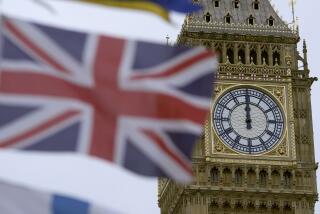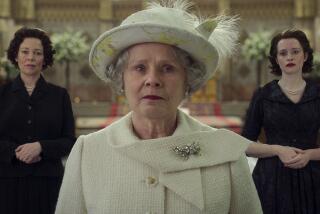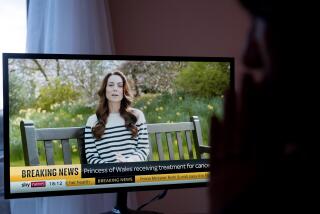Monarch in a well-tended cocoon
LONDON â Her face is everywhere: on stamps, coins, mugs and book covers. Her likeness has just been reproduced for the 23rd time at Madame Tussauds, Londonâs famous wax museum. More visitors come to gawp at her house than probably any other residence in the world.
Yet after reigning over Britain for longer than most of her subjects have been alive, Queen Elizabeth II is the countryâs âmost familiar enigma,â in the words of one TV presenter.
Yes, the white-haired 86-year-old keeps up a grueling schedule of public appearances that would test someone half her age, especially during this season of celebration of her Diamond Jubilee, marking 60 years on the throne. This weekend, the queen kicks off a four-day extravaganza by going to the races Saturday and cruising down the Thames on Sunday at the head of a flotilla of up to 1,000 boats.
But a certain regal aloofness, a touch of otherworldliness that lends some credence to the title âYour Majesty,â is a crucial component of her long success as monarch, some say.
âYou do need a little bit of mystique,â said Sue Daws, 52, who lives in northern Wales.
Note to heirs: You might want to work on that.
Elizabeth is the last member of the House of Windsor for whom royalty and celebrity donât overlap, or at least not by much, a distinction many observers credit with helping to preserve the monarchyâs appeal.
Her discretion and dignity are in marked contrast to the behavior of her four children. Unlike them, she doesnât submit to tell-all interviews about unhappy marriages, hasnât had details of her sex life laid bare in the tabloids, didnât take part (not even for charity) in an embarrassing game show called âThe Grand Knockoutâ in 1987 (as did Princess Anne and Princes Andrew and Edward, in a moment that for many Britons represented âthe breaking of royaltyâs magic spell,â as one writer later put it).
âThe queen has always avoided what she calls stunts,â said Robert Lacey, author of the just-published âThe Queen: A Life in Brief.â âThe monarchy has got to distinguish itself from other aspects of British public life.â
Part of Elizabethâs aura of solemn reserve is natural to her temperament and her generation, with its harrowing experience of world war and its innate aversion to making a spectacle. Lacey notes that she grew up in the era depicted in the movie âThe Kingâs Speechâ -- the king in question was her father -- when mass media were still novelties and engaging them wasnât automatically part of the British sovereignâs job description.
But some of the queenâs detached grandeur is carefully cultivated and maintained.
There are countless biographies, but no autobiography. Her public comments are polite, unexceptionable and totally unrevealing. Everyone knows about her love of dogs and horses, but only those closest to her have any real inkling of the thoughts beneath the diamond tiaras and behind the guarded smile.
âShe is the most portrayed individual in history, more than anyone you can think of -- popes, prime ministers, presidents,â said Paul Moorhouse, curator of a new exhibition, âThe Queen: Art & Image,â at the National Portrait Gallery here in London. âThe paradox is, what does anyone know about her? Her opinions are a closed book. Nobody but her intimate family knows what she thinks.â
Royal protocol certainly helps perpetuate the idea of a person set above and apart. At meals, guests are supposed to stop eating when the queen does. (Itâs said she keeps a final morsel on her plate to roll around so that others can keep noshing without embarrassment.) Even her family members have to rise when she enters.
But with that air of exaltedness comes a delicate juggling act, royal watchers and historians say.
Though fundamentally unknowable, the queen canât be too distant and unapproachable. At the same time, she must somehow give the impression of being close to her people. Her private motto is, âI have to be seen to be believed.â
âIn modern times, the British monarchy has been an accommodation of two opposing factors. One is a sense of aloofness or majesty or royalty, and the other is the opposite, the sense of being almost an ordinary human being,â said Michael Billig, a social scientist at Loughborough University. âIf they donât get that balance right, theyâre likely to be unpopular.â
Hence her many appearances opening hospitals, christening ships and inspecting military regiments, always in her trademark hat and pearls. In fact, when Britons are asked to explain their admiration of the queen, many talk about how diligent she is in dispatching her duties, how the âold girlâ soldiers on despite her age. She is only the second British monarch to celebrate a diamond jubilee; the first was her great-great-grandmother Victoria, 115 years ago.
âThe queen has become popular because there she is, an elderly woman whoâs still working,â Billig said. âThatâs a very down-to-earth assessment.â
Popular is right: The left-wing Guardian, which is staunchly republican on its editorial pages, nonetheless published a front-page story last month on the record popularity that âbrand Windsorâ currently enjoys.
The queen consistently ranks as the most beloved representative of that brand; thousands of well-wishers greet her wherever she goes, eager for some sort of connection. The question is how well the royal family will be able to sustain that semi-magical appeal once sheâs gone.
Many of the queenâs numerous progeny maintain just as taxing a regimen of charity work, royal âwalkaboutsâ and other ornamental appearances.
Yet unlike her, they have all had the veil of mystery stripped away to some degree, often in the most unflattering of ways. Prince Charlesâ recorded phone conversation with his then-mistress, now-wife, Camilla Parker-Bowles, still induces winces more than 20 years later, particularly the royal references to feminine hygiene products.
That kind of exposure might be in keeping with modern celebrity, but doesnât necessarily suit a centuries-old monarchy.
âWhen [the queen] goes, itâll completely change. Itâll turn the corner,â said Daws of north Wales. âIf you look now, theyâre very touchy-feely, whereas with her, thereâs this boundary around her.â
--
More to Read
Sign up for Essential California
The most important California stories and recommendations in your inbox every morning.
You may occasionally receive promotional content from the Los Angeles Times.











